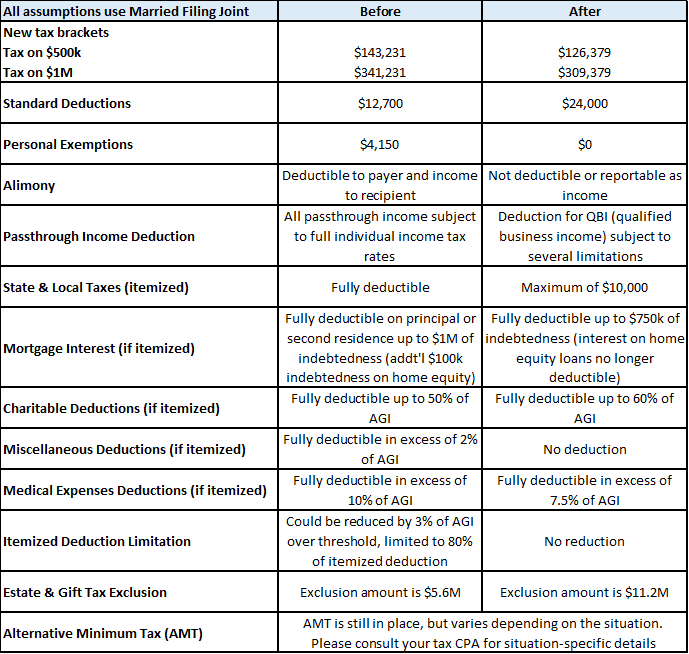The Impact of the New Tax Laws for Individuals
As we round out the first half of 2018, many are shifting their attention (if they haven’t already) to the tax reform that went into place at the beginning of the year. What I’ve found fascinating is that through my conversations with various tax professionals, no one is exactly sure what to expect come next spring. Yes, we have the general guidance from the IRS, but the full extent of the reform, in my opinion, is still not understood. Here’s why:
THE QUESTION
The first question that arises when I’m talking to someone about the tax reform is Will I pay more or less taxes in 2018? To say that this is a loaded question is an understatement.
THE ANSWERS
How much? Several factors will determine the impact of the new tax bill. For one, how much income will you have? The reason this matters is because the tax brackets have been adjusted. If you are a single person with average earnings, you might see a slight spike in your tax because income from [approximately] $40,000 to $80,000 is taxed at 22% instead of 15%. If you’re married and have high earnings, you might see a slight decrease in your taxes because the maximum tax dropped from 39.6% to 37% and you won’t hit that top bracket until $600,000 as opposed to $470,000 in 2017.
What’s life like? Secondly, What stage of life are you in? Do you have 3 dependents living in the house? Are you single? Do you have multiple homes with mortgage interest? The new tax law might be showing you a nice reduction in your adjusted gross income, but you could be saying goodbye to some of those nice itemized deductions you had taken in the past. Here are a couple of the deductions that are no longer eligible:
No more personal exemptions ($4,150 per person)
State, local, and real estate taxes limited to $10,000 in aggregate
No more miscellaneous deductions subject to 2% floor
Investment advisor fees
Legal fees
Tax prep fees
While the itemized deductions took a hit, the standard deduction was increased from $6,350 to $12,000 for single filers and from $12,700 to $24,000 for married filers.
What kind? Lastly, What kind of income will you have? If you have significant income from partnership investments, you may qualify for the new passthrough deduction which can reduce your income from those investments by up to 20%. This new deduction is the one I have found most interesting as many of the tax practitioners I’ve spoken to still don’t fully know how this will play out when people are filing their 2018 returns next year.
THE REAL ANSWER
If you’re like me, after reading this, you still don’t have a confident answer to Will I pay more or less in taxes in 2018? That is the strange consensus that I’ve heard over and over again from tax preparers, educational classes, and clients alike. Your tax bracket may be more favorable, but you are losing some itemized deductions. Or perhaps your tax bracket is less favorable, but your standard deduction is larger. In general, I don’t think many of us will see any drastic changes in our tax bills. We’ve simply moved our apples to a different basket and shaken it up a bit.
Each person’s tax situation is unique and could fall outside the realm of these general tax assumptions. Thus, this paper is not meant to provide specific tax advice, but rather a general idea of the new tax law. Contact your CPA for situation-specific advice. Below is a table outlining some of the major changes in the new tax law.
Partnering with you in Excellence.


